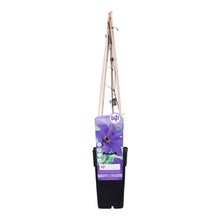Clematis 'President' is a vigorous and popular large-flowered clematis cultivar, celebrated for its abundant, deep purple-blue blooms. This clematis produces masses of showy flowers, up to 15cm (6in) in diameter, with overlapping, velvety petals and contrasting reddish-purple anthers. It flowers profusely in late spring and early summer, with a possible second flush of blooms in late summer. It's a versatile climber, suitable for growing in gardens, containers, or even as a small, manageable climber in more compact spaces. It belongs to the Ranunculaceae family.
Origin: Clematis 'President' was bred by Charles Noble in England and introduced in 1876.
Light: Clematis 'President' thrives in full sun to partial shade. Ideally, it prefers its "head in the sun and its feet in the shade." This means the upper part of the plant should receive plenty of sunlight, while the roots should be kept cool and shaded.
Water: Water regularly, especially during dry periods and the first year after planting. Clematis prefer consistently moist soil, but avoid overwatering, which can lead to root rot.
Soil: Clematis 'President' prefers well-drained, fertile soil. It can tolerate a range of soil types, but thrives in loamy soil with a slightly acidic to neutral pH.
Support: As a climber, Clematis 'President' needs support to grow. Provide a trellis, obelisk, or other structure for it to climb on.
Pruning: Clematis 'President' belongs to pruning group 2. This means it flowers on both old and new wood. Prune lightly in late winter or early spring, removing any dead or weak stems. After the first flush of flowers in early summer, prune back some stems to encourage a second flush later in the season.
Hardiness: Clematis 'President' is hardy and can tolerate cold winters.
Uses: This clematis is primarily grown as an ornamental climber for its attractive flowers. It's a popular choice for adding vertical interest to gardens, patios, and balconies.
Toxicity: Clematis 'President' is toxic to dogs, cats, and horses if ingested.



